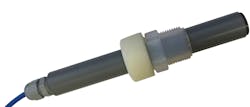Predicting Climate Change Driven Toxic Algae Blooms With Intelligent Fluorescence Sensor Technology
Water resource engineers and managers responsible for the safety of municipal drinking water systems, raw water supply storage projects and busy summer water recreational areas popular for swimming or fishing will find the sophisticated Model EV82 Environmental Sensor Series from Electro Chemical Devices helps them detect rising chlorophyll levels accurately and reliably in their efforts to prevent toxic harmful algae blooms (HABs).
Scientists around the globe who are studying climate change point increasingly to its effects on the quality of the water supply. Drought conditions as well as rising industrial and agricultural activity have been blamed in part for the increasing organic load nutrient levels from fertilizers and other run-off pollutants in surface water that lead to rising seasonal chlorophyll growth levels, which are ripe for full toxic algae blooms causing more environmental damage.
Detecting rising levels of chlorophyll and algae in water samples helps water engineers ensure proper disinfection and effective treatment of surface water to protect municipal drinking water quality. Recent studies, sponsored by the U.S. Environmental Protection Agency and other agencies, of the Great Lakes, major rivers and other surface water systems are pointing toward climate change as a potential cause of the rising number of algae bloom problems.
ECD’s field-proven Triton EV82 Sensors measure chlorophyll, algae, phytoplankton, cyanobacteria and other plant matter. These sensors utilize state-of-the-art fluorescence sensing technology that detects chlorophyll levels and come in four unique optical configurations for water quality and environmental applications. Also available is Cyanobacteria Sensors for blue-green algae, which measures phycocyanin for freshwater cyanobacteria or phycoerythrin for marine water cyanobacteria. EV82 sensors are typically used to measure rising or falling trends of the desired measurement parameter chosen and then the sensor is pre-calibrated at the factory.
EV82 Toxic Algae Bloom Sensor
The EV82 Sensors incorporate ECD’s intelligent design, which features built-in digital serial communications. The measurement parameter’s calibration data is stored in the sensor allowing plug-and-play field installation of a pre-calibrated sensor. The EV82 sensors also directly connect to the ECD T80 Universal Transmitter, the ECD LQ800 Multi-Channel Controller or directly with any control system’s programmable logic controller (PLC) via the sensor’s built-in serial communication.
The minimum chlorophyll sensing ranges available are a choice of either 0.03 ug/L (blue excitation method) or 0.3 ug/L (red excitation method). The Model EV82’s rugged, submersible IP-68 rated standard sensor operates at depths of up to 33 feet (10 meters) for maximum flexibility, with greater depths available.
The Model EV82’s easy-to-install sensor features a rugged, secure mounting that is accomplished with the provided pipe thread for a permanent standpipe installation. No special tools or extensive training are required. The sensor operates over a wide temperature range from 32 to 122 °F (0 to 50 °C) for application versatility.
The T80 Transmitter and the LQ800 Multi-Channel Controller are also both simple to install for a full analyzer capability. They feature built-in power supplies that operate over 24 VDC power. Just plug them in and they’re ready to go. Outputs are via Modbus RTU RS485 digital communications, and they also include LCD displays with highly intuitive menus that will appeal to busy technicians.
Maintenance requirements are minimized by the Model EV82 Analyzer’s thoughtful sensor design, which features a smooth parallel optical sensing surface. This design reduces potential algae contamination without the need for extra cleaning maintenance by busy plant technicians. Ease of installation and low maintenance requirements reduce this analyzer’s total installed and lifecycle costs.
Editor's Note: Scranton Gillette Communications and the SGC Water Group are not liable for the accuracy, efficacy and validity of the claims made in this piece. The views expressed in this content do not reflect the position of the editorial teams of Water & Wastes Digest, Water Quality Products and Storm Water Solutions.

